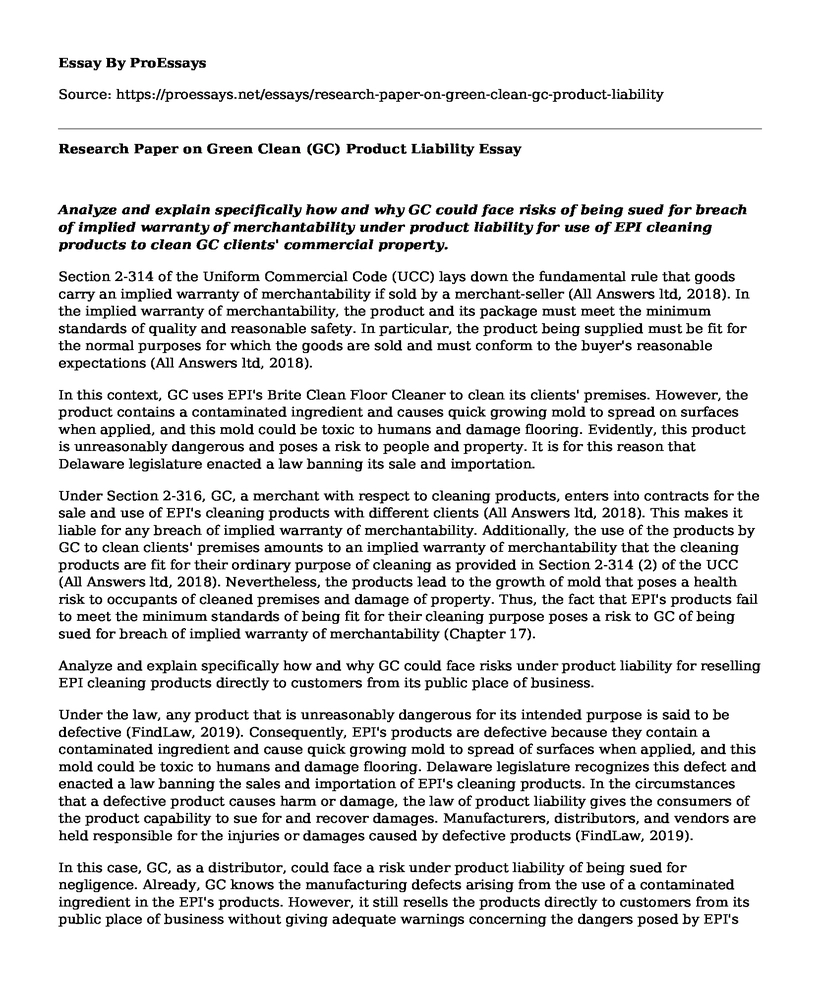Analyze and explain specifically how and why GC could face risks of being sued for breach of implied warranty of merchantability under product liability for use of EPI cleaning products to clean GC clients' commercial property.
Section 2-314 of the Uniform Commercial Code (UCC) lays down the fundamental rule that goods carry an implied warranty of merchantability if sold by a merchant-seller (All Answers ltd, 2018). In the implied warranty of merchantability, the product and its package must meet the minimum standards of quality and reasonable safety. In particular, the product being supplied must be fit for the normal purposes for which the goods are sold and must conform to the buyer's reasonable expectations (All Answers ltd, 2018).
In this context, GC uses EPI's Brite Clean Floor Cleaner to clean its clients' premises. However, the product contains a contaminated ingredient and causes quick growing mold to spread on surfaces when applied, and this mold could be toxic to humans and damage flooring. Evidently, this product is unreasonably dangerous and poses a risk to people and property. It is for this reason that Delaware legislature enacted a law banning its sale and importation.
Under Section 2-316, GC, a merchant with respect to cleaning products, enters into contracts for the sale and use of EPI's cleaning products with different clients (All Answers ltd, 2018). This makes it liable for any breach of implied warranty of merchantability. Additionally, the use of the products by GC to clean clients' premises amounts to an implied warranty of merchantability that the cleaning products are fit for their ordinary purpose of cleaning as provided in Section 2-314 (2) of the UCC (All Answers ltd, 2018). Nevertheless, the products lead to the growth of mold that poses a health risk to occupants of cleaned premises and damage of property. Thus, the fact that EPI's products fail to meet the minimum standards of being fit for their cleaning purpose poses a risk to GC of being sued for breach of implied warranty of merchantability (Chapter 17).
Analyze and explain specifically how and why GC could face risks under product liability for reselling EPI cleaning products directly to customers from its public place of business.
Under the law, any product that is unreasonably dangerous for its intended purpose is said to be defective (FindLaw, 2019). Consequently, EPI's products are defective because they contain a contaminated ingredient and cause quick growing mold to spread of surfaces when applied, and this mold could be toxic to humans and damage flooring. Delaware legislature recognizes this defect and enacted a law banning the sales and importation of EPI's cleaning products. In the circumstances that a defective product causes harm or damage, the law of product liability gives the consumers of the product capability to sue for and recover damages. Manufacturers, distributors, and vendors are held responsible for the injuries or damages caused by defective products (FindLaw, 2019).
In this case, GC, as a distributor, could face a risk under product liability of being sued for negligence. Already, GC knows the manufacturing defects arising from the use of a contaminated ingredient in the EPI's products. However, it still resells the products directly to customers from its public place of business without giving adequate warnings concerning the dangers posed by EPI's cleaning products.
Notably, GC has a duty of care to its clients. Nevertheless, this duty of care is breached when GC sells the defective EPI's cleaning products and uses them to clean its clients' premises. The breach results in harm to customers' health and damage to property (Chapter 17).
Similarly, GC could be liable for physical harm caused by the EPI's products to consumers' health and property under strict liability. Moreover, the company sells the products in a defective condition unreasonably dangerous to the customers (Chapter 17). In particular, GC could face a risk of being sued for the physical harm that results from the mold, either to people's health or to surfaces.
References
All Answers ltd. (2018). Exploring Warranties and Product Liability. Retrieved from https://www.lawteacher.net/free-law-essays/contract-law/exploring-warranties-and-product-liability-contract-law-essay.phpChapter 17. Product Liability
FindLaw. (2019). Product Liability: Manufacturing Defects vs. Design Defects. Retrieved from https://corporate.findlaw.com/litigation-disputes/product-liability-manufacturing-defects-vs-design-defects.html
Cite this page
Research Paper on Green Clean (GC) Product Liability. (2022, Nov 14). Retrieved from https://proessays.net/essays/research-paper-on-green-clean-gc-product-liability
If you are the original author of this essay and no longer wish to have it published on the ProEssays website, please click below to request its removal:
- Cultural Clashes and Joint Ventures
- Marketing Strategy of Health Cafe
- Legal Protection for the Individual Employee Paper Example
- A Business Plan for a Breakfast Restaurant Paper Example
- The Fair Labor Standards Act Essay Example
- Essay Example on Hotels' Rate Parity: Achieving Brand Loyalty With Strategic Pricing
- Essay Example on KFC Supply Chain: Simplified Flow Process







